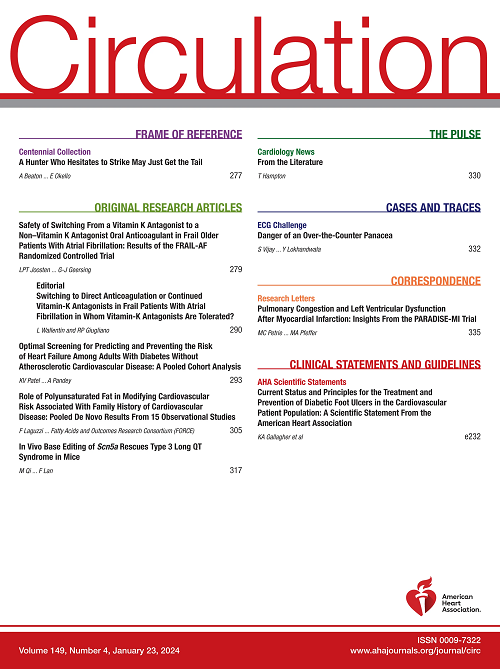他汀类药物治疗和剂量与男性小腹主动脉瘤临床病程的关系:来自两项基于人群的筛查试验的5年前瞻性队列研究
IF 35.5
1区 医学
Q1 CARDIAC & CARDIOVASCULAR SYSTEMS
引用次数: 0
摘要
背景腹主动脉瘤(AAA)偶尔破裂时具有很高的发病率和死亡率。虽然在多项荟萃分析中,二甲双胍和他汀类药物已被确定为潜在的治疗方法,但尚未成功证明药物治疗可减少AAA生长。本研究旨在探讨他汀类药物的使用与AAA生长速率、修复、破裂或死亡风险之间的潜在关系。方法:研究人群包括2项大型、基于人群的随机筛选试验中所有筛查出AAAs (30-55 mm)的男性;维堡血管筛查试验(纳入,2008-2011)和丹麦心血管筛查试验(纳入,2014-2018)。临床数据库补充了来自全国丹麦医疗保健登记处的数据,包括处方和结果数据。他汀暴露量以限定日剂量(DDD)量化。主要终点是AAA生长速率,而次要终点包括修复的需要以及修复、破裂和全因死亡的综合结果。增长率用线性回归计算。为了评估修复风险,患者从入组到手术、破裂、死亡、5年随访或2021年12月31日进行随访。结果动脉瘤男998例,中位年龄69.5岁[四分位间距(IQR), 67 ~ 72]岁;中位AAA直径35.4 [IQR, 32-41.2] mm)。他汀类药物的使用与AAA生长速率降低显著相关;每天增加1 DDD的他汀类药物与-0.22 mm/年的调整生长率变化相关[95% CI, -0.39至-0.06];P = 0.009)。他汀类药物每增加一倍进行修复的5年校正风险比(HR)显著降低,为0.82 ([95% CI, 0.70-0.97];P=0.023), 2.5年后差异有统计学意义。他汀类药物的使用与复合结局(手术、破裂和死亡)的风险呈剂量依赖性显著降低相关,调整后的HR为0.83 ([95% CI, 0.73-0.94];P=0.003)。结果在各种敏感性分析中都是稳健的。结论:大剂量他汀类药物与AAA生长速率降低、修复、破裂和死亡风险降低相关。这项非随机研究表明,AAA患者可以从大剂量他汀类药物的使用中获益,而不仅仅是针对相关的危险因素。本文章由计算机程序翻译,如有差异,请以英文原文为准。
Association of Statin Treatment and Dose With the Clinical Course of Small Abdominal Aortic Aneurysms in Men: A 5-Year Prospective Cohort Study From 2 Population-Based Screening Trials.
BACKGROUND
Abdominal aortic aneurysms (AAA) present with high morbidity and mortality when they occasionally rupture. No medical therapy has successfully been proven to reduce AAA growth, though both metformin and statins have been identified as potential treatments in multiple meta-analysis. This study aimed to investigate a potential relationship between statin use and AAA growth rates and risk of undergoing repair, rupture, or death.
METHODS
The study population included all men with screening-detected AAAs (30-55 mm) from the 2 large, population-based, randomized screening trials; the Viborg Vascular Screening trial (inclusion, 2008-2011) and the Danish Cardiovascular Screening trial (inclusion, 2014-2018). The clinical database was supplemented with data from the nationwide Danish Healthcare Registries, including prescription and outcome data. Statin exposure was quantified by defined daily doses (DDD). The primary outcome was AAA growth rate, whereas secondary outcomes included the need for repair and a composite of repair, rupture, and all-cause death. Growth rates were calculated using linear regression. To evaluate the risk of repair, patients were followed from inclusion until surgery, rupture, death, 5-year follow-up, or December 31, 2021.
RESULTS
A total of 998 aneurysmal men (median age, 69.5 [interquartile range (IQR), 67-72] years; median AAA diameter, 35.4 [IQR, 32-41.2] mm) were included. Statin use was significantly associated with reduced AAA growth rate; an increase of 1 DDD statin per day was associated with an adjusted change in growth rate of -0.22 mm/year [95% CI, -0.39 to -0.06]; P=0.009). The 5-year adjusted hazard ratio for undergoing repair per doubling of statin dose presented a significantly reduced adjusted hazard ratio (HR) of 0.82 ([95% CI, 0.70-0.97]; P=0.023), which was significant after 2.5 years. Statin use was associated with a significantly lower risk of the composite outcome (surgery, rupture, and death) in a dose-dependent manner, with an adjusted HR of 0.83 ([95% CI, 0.73-0.94]; P=0.003) per doubling of statin dose. Findings were robust in a variety of sensitivity analyses.
CONCLUSIONS
High-dose statin use was associated with decreased AAA growth rates and lowered risk of undergoing repair, rupture, and death. This nonrandomized study suggests that patients with AAA could benefit from high-dose statin use, beyond only targeting associated risk factors.
求助全文
通过发布文献求助,成功后即可免费获取论文全文。
去求助
来源期刊

Circulation
医学-外周血管病
CiteScore
45.70
自引率
2.10%
发文量
1473
审稿时长
2 months
期刊介绍:
Circulation is a platform that publishes a diverse range of content related to cardiovascular health and disease. This includes original research manuscripts, review articles, and other contributions spanning observational studies, clinical trials, epidemiology, health services, outcomes studies, and advancements in basic and translational research. The journal serves as a vital resource for professionals and researchers in the field of cardiovascular health, providing a comprehensive platform for disseminating knowledge and fostering advancements in the understanding and management of cardiovascular issues.
 求助内容:
求助内容: 应助结果提醒方式:
应助结果提醒方式:


